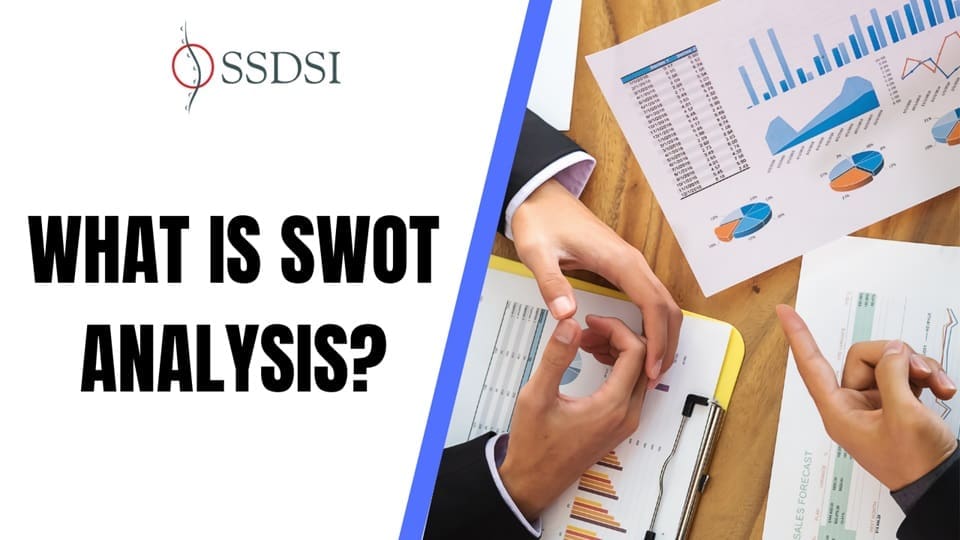SWOT analysis is a strategic tool used by organizations to evaluate their internal and external environments. The acronym stands for Strengths, Weaknesses, Opportunities, and Threats, which represent key elements that influence a business’s success.
This analysis helps companies gain a clearer understanding of their current situation, allowing them to make informed decisions that can enhance performance, address challenges, and seize opportunities.
Whether you’re a startup looking to establish your market presence or a well-established corporation seeking to maintain a competitive edge, conducting a SWOT analysis is crucial. It acts as a mirror, reflecting both the positive and negative aspects of your business, and guiding you toward strategic planning and effective decision-making.
Table of contents
What is SWOT Analysis?
SWOT analysis is a strategic planning tool used by organizations to evaluate their internal and external environments. It stands for Strengths, Weaknesses, Opportunities, and Threats.
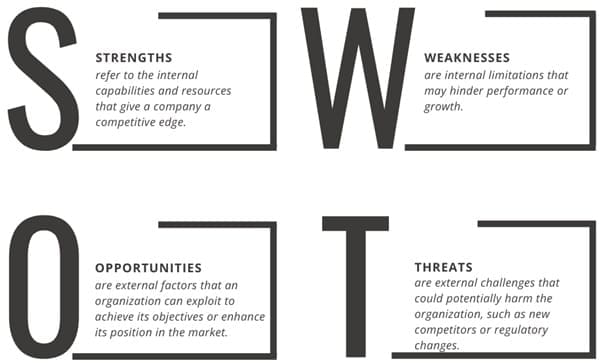
Strengths refer to the internal capabilities and resources that give a company a competitive edge.
Weaknesses are internal limitations that may hinder performance or growth.
Opportunities are external factors that an organization can exploit to achieve its objectives or enhance its position in the market.
Threats are external challenges that could potentially harm the organization, such as new competitors or regulatory changes.
By conducting a SWOT analysis, businesses gain a comprehensive understanding of their current situation.
This insight allows them to develop strategies that leverage strengths, address weaknesses, capitalize on opportunities, and mitigate threats. It is a versatile tool that aids in decision-making, strategic planning, and problem-solving, making it essential for navigating the complexities of today’s competitive environment.
History and Evolution of SWOT Analysis
SWOT analysis was developed in the 1960s by researchers at the Stanford Research Institute to help American corporations improve their strategic planning outcomes. It was designed as a simple yet effective tool to help businesses identify their strengths, weaknesses, opportunities, and threats, ultimately enhancing their strategic planning processes.
Over the years, SWOT analysis has evolved and is now widely used across various industries, from business to healthcare, education, and even personal development. Its simplicity, versatility, and effectiveness have made it a staple in strategic planning.
Components of SWOT
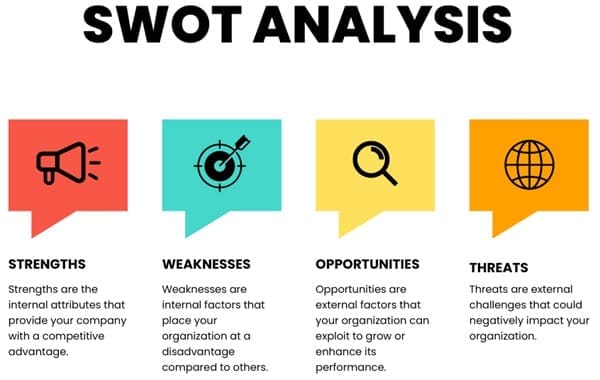
Strengths
Strengths are the internal attributes that provide your company with a competitive advantage. These elements are the building blocks of your success and include resources, capabilities, and any other positive attributes that help your organization achieve its goals. Identifying and leveraging your strengths is essential for maintaining a competitive edge in the market.
For example, a strong brand reputation, a loyal customer base, or superior technology are all strengths that can set your company apart from competitors. Acknowledging these strengths allows you to build strategies that capitalize on what you do best.
Weaknesses
Weaknesses are internal factors that place your organization at a disadvantage compared to others. These are areas where your company may lack resources, capabilities, or efficiencies. Identifying weaknesses is not about pointing fingers but rather understanding where improvements are needed.
Common weaknesses might include poor financial management, outdated technology, or a shortage of skilled employees. By recognizing these weaknesses, you can develop strategies to address them, turn them into strengths, and ultimately improve your business performance.
Opportunities
Opportunities are external factors that your organization can exploit to grow or enhance its performance. These factors represent potential avenues for expansion, innovation, or improvement. Understanding and acting on opportunities can lead to significant business growth.
For instance, a company might identify an underserved market segment, a technological advancement that could streamline operations, or a partnership that could boost market presence. Seizing these opportunities is key to staying ahead in a competitive landscape.
Threats
Threats are external challenges that could negatively impact your organization. These might include new competitors, regulatory changes, economic downturns, or technological disruptions. Identifying potential threats allows you to prepare contingency plans and strategies to mitigate their impact.
For example, if a new competitor enters the market, your company might need to adjust its pricing strategy, improve product offerings, or enhance customer service to maintain its market position.
When to Use SWOT Analysis?
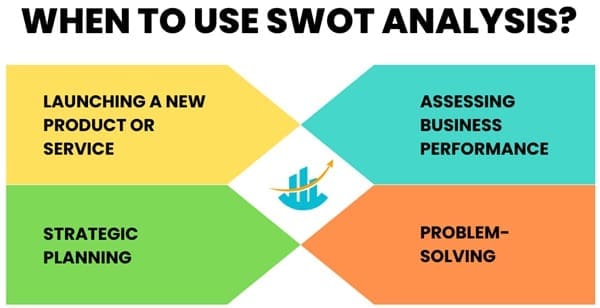
- Launching a New Product or Service: Before introducing a new product or service to the market, it’s essential to understand its potential strengths and weaknesses, as well as the opportunities and threats in the market. A SWOT analysis helps you evaluate these factors, ensuring a well-informed launch strategy.
- Assessing Business Performance: Conducting a SWOT analysis allows you to evaluate the overall performance of your business. By identifying areas where you excel and areas that need improvement, you can make data-driven decisions to enhance your company’s operations and outcomes.
- Strategic Planning: During the planning phase of any major business decision, such as mergers, acquisitions, or entering a new market, a SWOT analysis provides valuable insights. It helps you align your strategies with your organization’s strengths and market conditions.
- Problem-Solving: If your organization faces a particular challenge, a SWOT analysis can help you identify the root cause and develop strategies to overcome it. By understanding the internal and external factors at play, you can create effective solutions to address the issue.
Why Use SWOT Analysis?
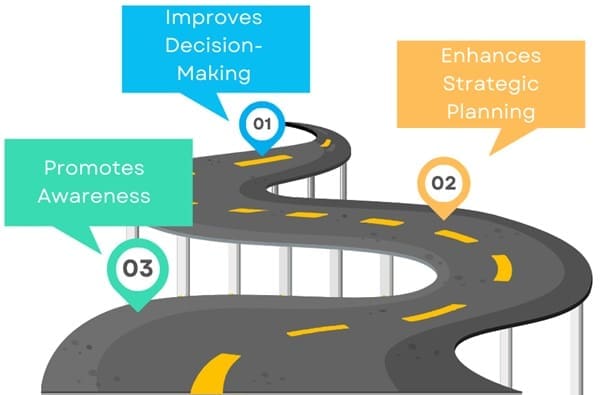
- Improves Decision-Making: SWOT analysis provides a clear framework for making informed decisions. By understanding your strengths, weaknesses, opportunities, and threats, you can develop strategies that align with your goals and resources, leading to better business outcomes.
- Enhances Strategic Planning: SWOT analysis is a foundational tool in strategic planning. It helps organizations craft strategies that capitalize on strengths, address weaknesses, seize opportunities, and mitigate threats, ensuring a comprehensive approach to business growth and development.
- Promotes Awareness: Conducting a SWOT analysis forces you to take a comprehensive look at your organization. This promotes awareness of both internal and external factors that can impact your success, allowing you to proactively address challenges and capitalize on opportunities.
Conducting a SWOT Analysis
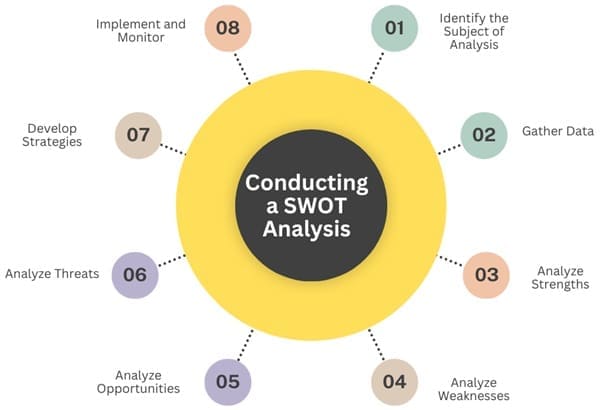
- Identify the Subject of Analysis: Clearly define the subject of the analysis. This could be a specific project, product, business unit, or the entire organization.
- Gather Data: Collect data relevant to each of the four components: strengths, weaknesses, opportunities, and threats. This might include financial records, market research, competitor analysis, customer feedback, and internal performance metrics.
- Analyze Strengths: Begin by focusing on the internal factors that give your organization a competitive advantage. Consider what your company does well, what resources you have, and what unique qualities set you apart from the competition. Document these strengths and think about how they can be leveraged to achieve your business objectives.
- Analyze Weaknesses: Next, take an honest look at the internal factors that put your organization at a disadvantage. Identify areas where you are lacking resources, capabilities, or efficiencies. Recognizing these weaknesses is essential for developing strategies to address them and convert them into strengths.
- Analyze Opportunities: Look externally to identify opportunities for growth and improvement. Consider market trends, technological advancements, and other factors that could benefit your organization. Opportunities should be evaluated in the context of your company’s strengths and weaknesses to determine how best to pursue them.
- Analyze Threats: Identify external challenges that could negatively impact your organization. Consider competition, regulatory changes, economic conditions, and other factors that could pose a threat. Understanding these threats allows you to develop contingency plans and strategies to mitigate their impact.
- Develop Strategies: Based on your analysis, develop strategies to leverage your strengths, address your weaknesses, capitalize on opportunities, and mitigate threats. This might involve strategic planning, process improvements, new product development, or other initiatives.
- Implement and Monitor: Implement the strategies developed from your SWOT analysis and monitor their effectiveness over time. Adjust your approach as needed to ensure continued success.
Practical Examples of SWOT Analysis
Example 1: Tech Startup
- Strengths: Innovative product, strong technical team, first-mover advantage.
- Weaknesses: Limited financial resources, and small market presence.
- Opportunities: Growing market demand, and potential partnerships with established companies.
- Threats: Competition from larger tech companies, rapid technological changes.
For a tech startup, the innovative product and strong technical team provide a significant competitive edge, especially if they are the first to market. However, limited financial resources and a small market presence may hinder growth. The company should focus on leveraging its strengths to form strategic partnerships and capitalize on the growing market demand while being mindful of the competition and rapid technological changes that could pose a threat.
Example 2: Retail Business
- Strengths: Strong brand reputation, loyal customer base, prime location.
- Weaknesses: High operating costs, and limited online presence.
- Opportunities: Expansion into e-commerce, increased demand for sustainable products.
- Threats: Economic downturn, new competitors entering the market.
A retail business with a strong brand reputation and a loyal customer base is well-positioned in the market. However, high operating costs and limited online presence may restrict profitability. The business could explore opportunities in e-commerce and sustainable products, which are increasingly in demand. At the same time, it should be prepared to face potential threats like an economic downturn or new competitors entering the market.
Benefits
- Simplicity: SWOT analysis is easy to understand and apply, making it accessible to organizations of all sizes. Its straightforward framework allows businesses to quickly identify key factors influencing their success.
- Versatility: The versatility of SWOT analysis means it can be used in a wide range of situations, from business planning to personal development. It provides valuable insights regardless of the industry or sector.
- Strategic Insight: SWOT analysis provides strategic insights that can inform decision-making and help organizations achieve their goals. By offering a clear picture of internal and external factors, it supports informed strategy development.
Limitations
- Subjectivity: SWOT analysis relies on the perspectives of those conducting the analysis, which can lead to biased or incomplete assessments. The accuracy of the analysis depends on the objectivity and thoroughness of the participants.
- Lack of Depth: While SWOT provides a broad overview, it may not offer the depth of analysis required for complex decision-making. It is often used in conjunction with other strategic tools for a more comprehensive evaluation.
- Static Snapshot: SWOT analysis provides a snapshot of a particular moment in time, which may not fully capture the dynamic nature of the business environment. Regular updates are necessary to maintain its relevance.
Final Words
SWOT analysis remains an essential tool in strategic planning, offering a structured approach to understanding the internal and external factors that influence business success. By identifying strengths, weaknesses, opportunities, and threats, organizations can develop effective strategies that align with their goals and resources.
For businesses looking to thrive in today’s competitive environment, conducting a thorough and objective SWOT analysis is a vital step in the strategic planning process. Whether you’re a startup navigating new markets or an established company seeking to maintain your market position, SWOT analysis provides the insights needed to make informed decisions and drive success.

About Six Sigma Development Solutions, Inc.
Six Sigma Development Solutions, Inc. offers onsite, public, and virtual Lean Six Sigma certification training. We are an Accredited Training Organization by the IASSC (International Association of Six Sigma Certification). We offer Lean Six Sigma Green Belt, Black Belt, and Yellow Belt, as well as LEAN certifications.
Book a Call and Let us know how we can help meet your training needs.

